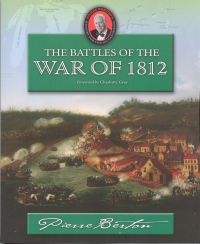| ________________
CM . . .
. Volume XIII Number 5 . . . .October 27, 2006 
 |
The Battles of the War of 1812; An Omnibus.
Pierre Berton.
Calgary, AB: Fifth House, 2006.
317 pp., pbk., 21.95.
ISBN 1-897252-01-3.
Subject Headings:
Canada-History-War of 1812-Campaigns-Juvenile literature.
Contains the following books originally published by McClelland & Stewart:
The Capture of Detroit. 1991
The Death of Isaac Brock. 1991.
Revenge of the Tribes. 1991.
Canada Under Siege. 1991.
The Battle of Lake Erie. 1994.
The Death of Tecumseh. 1994.
Attack on Montreal. 1995.
Grades 6-10 / Ages 11-15.
Review by Thomas F. Chambers.
***˝ /4
|
| |
|

excerpt:
Atherton, near the door, managed to slip out of the room, only to come face to face with one of the most savage-looking Indians he had ever seen. His face was painted jet black. Half a bushel of feathers was fastened to his scalp lock. An immense tomahawk gleamed in his right hand. A scalping knife hung from his belt. He seized Atherton by the collar, propelled him out the front door, led him through the gate and down the river for a hundred yards (90 m) to the home of Jean-Baptiste Jerome, where several wounded officers had spent the night. The building had also done duty as a tavern, and the Indians were ransacking the cellars for whisky.
In front of the house, Atherton saw a scarecrow figure, bleeding, barefoot, and clad only in a shirt and drawers. This was Captain Nathanial Hart, commander of the Lexington Light Infantry, inspector of the Northwest Army. He was the messenger whom Harrison sent to Winchester thenight before the battle. He was twenty-eight and wealthy, having made a fortune in hemp. Now he was pleading for his life.
There are seven battles included in The Battles of the War of 1812, including The Capture of Detroit, The Death of Isaac Brock and The Death of Tecumseh. The account of each is broken down into from seven to eleven small chapters of from four to eight pages. These give a very detailed account of the battles, an account so vivid that pictures of them are clearly formed in the reader's mind. In Berton's hands, one can almost hear the muskets firing, smell the gunpowder, and experience the fear and excitement felt by the soldiers. This is history as it should be told.
The battles described were previously published as individual books in the “Adventures in Canadian History” series. They are examples of Berton at his best. War tends to stimulate feeling of patriotism in the citizens of the countries involved, and Berton, in this book, and his many others wanted to instill a love of Canada and its history in his readers. The fact that he became one of Canada's most popular interpreters of this history is proof of his success. Readers of this book should feel a sense of pride in the accomplishments of the Canadians involved in these struggles. If they do, then Berton will have succeeded.
One well-known battle, the Battle of New Orleans, is omitted from this book. This is a shame because its exclusion gives a distorted interpretation of the War of 1812. While the battle was fought 15 days after the war was ended by the Treaty of Ghent, it took place because of the war and is considered to be a part of the war. Unlike the battles included in Berton's book, it was a disaster for the British and is an example of the utter stupidity of war. While there was a considerable loss of life in the other battles, the magnitude of the British losses in this battle almost overshadows their previous victories.
Few writers have done as much to popularize Canadian history as Berton. His account of the battles in this book is well researched and accurate. However, no references are given to show where Berton obtained his facts. This is a liability for anyone wishing to delve more deeply into the history.
On occasion, Berton gives a different interpretation than the standard one of some of the events mentioned. One example concerns the American general, William Hull, the commander of Fort Detroit who surrendered without a fight to the British general, Isaac Brock. Most portrayals of the surrender conclude by describing Hull as a coward of the worst kind who betrayed his country. Berton is less harsh in his assessment, writing that "soldiers---because of him, could now go back whole to the comfort of their homesteads." And, "had he refused to surrender---would have been swept into the history books as a gallant martyr." Berton's Hull is a well-meaning man overwhelmed by events.
The Battles of the War of 1812 is written in a style that will be easily understood by the target readership, and the book is one that should stimulate a strong interest in Canadian history. It could be used for both classroom support and recreational reading. It is illustrated throughout with a small number of decorative photographs. Each chapter has excellent, functional maps,
which show the locations of the battles. Each of the seven chapters has its own index. An innovative teacher will find many ways in which to use this book.
Highly Recommended.
A retired college teacher, Thomas F. Chambers lives in North Bay, ON.

To comment
on this title or this review, send mail to cm@umanitoba.ca.
Copyright © the Manitoba Library Association. Reproduction for personal
use is permitted only if this copyright notice is maintained. Any
other reproduction is prohibited without permission.
NEXT REVIEW |
TABLE OF CONTENTS FOR THIS ISSUE
- October 27, 2006.
AUTHORS |
TITLES |
MEDIA REVIEWS |
PROFILES |
BACK ISSUES |
SEARCH |
CMARCHIVE |
HOME |
